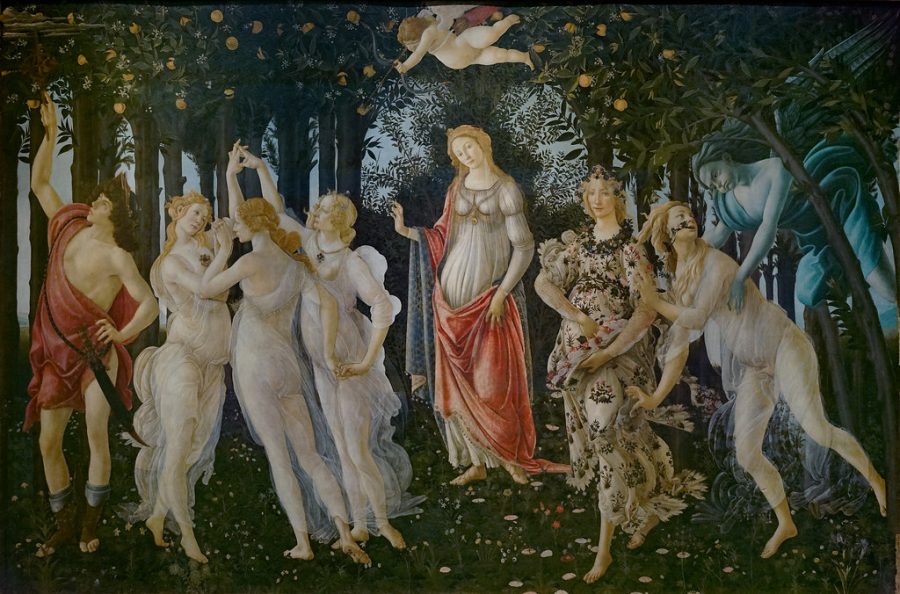“Primavera”: a brief reflection on Greek mythology and the Renaissance
Ethan Crowley writes about the significance of Botticelli’s “Primavera’ in modern society.
May 1, 2023
Sandro Botticelli was an esteemed Renaissance painter whose work was highly revered during his lifetime. He stood out amidst the many incredible painters Florence produced between 1450 and 1600, such as Giotto, Masaccio, Da Vinci and, undoubtedly the most recognizable, Michelangelo.
Botticelli was an excellent student and found himself bored by school, resulting in him being known as an easily distracted hyperactive kid. His talent was luckily recognized early and he was removed from school and placed into an art apprenticeship. His skill was immense and led to him working under Filippo Lippi and later Pollaiuolo, two famous Florentine painters.
Later, Botticelli joined Compagnia di San Luca, a confraternity of Florentine painters, which gave him access to influential people of the Renaissance like the Medici family and Pope Julius II. His Catholic connections provided the opportunity to paint the newly built walls of the Sistine Chapel.
Today, Botticelli’s most famous painting is considered to be “The Birth of Venus,” but I chose to discuss “Primavera” because it depicts a spring scene – something I feel like we are all desperately waiting to arrive at John Carroll.
While I don’t consider myself to be an art analyst or even someone particularly interested in Renaissance artwork yet “Primavera” is considered by many scholars to be an allegory for the numerous seminal movements started during the Renaissance, and thus, an interesting visual way of understanding the period.
“Primavera” depicts three separate narratives that art analysts believe aren’t specifically interconnected but still do contribute to an overarching story expressed in the painting.
On the right side of the painting are Zephyrus, Chloris and Flora. Zephyrus, the Greek God of the west wind, kidnaps the nymph Chloris and marries her. For reference, Nymphs in Greek mythology are usually a personification of nature and are typically depicted as maidens. After Zephyrus marries Chloris, she is transformed into the physical deity, Flora, who is standing to Chloris’ left in the painting. Flora is the Goddess of spring and can be seen spreading roses throughout the garden.
On the left side of the painting, the Three Graces are observed dressed in festive attire and dancing. The Three Graces are said to be daughters of Zeus and Hera, representing brightness, joyfulness, and bloom.
Standing to their left is the Greek god of May, Mercury. Standing in the center of the piece is Venus, adorned in clothing that would have been appropriate for a marriage at the time, and a blindfolded cupid flying above her. As an interesting side detail, over 500 plant species have been identified scattered throughout the painting’s landscape.
When the narrative’s characters and their symbolic meanings are viewed from right to left, a story of spring is told. Zephyrus, the wind, produces and spreads flowers by marrying Chloris and turning her into Flora. Venus is dressed in traditional marital garments as she is marrying the new springtime flowers brought forth by Flora with the Three Graces and the joy and new growth they represent. The final character, Mercury, represents May and the end of spring.
As mentioned earlier, “Primavera” is considered by some to be a great visual representation of the Renaissance. This perspective came from art historians who determined that Botticelli would not have likely known enough about Greek mythology to create this painting alone. Instead, it’s possible that Botticelli received guidance from some of his peers in the Medici circle. These individuals would have been influential members of Florentine society and likely well-informed about the ideas essential to the Renaissance movement at large.
One such movement at large was a change in the pedagogy during the Renaissance. More significance was placed on the humanities like rhetoric, history, and philosophy. Making a concept like Neo-Platonism, something that influenced the Medici’s possible guidance given to Botticelli, a reasonable theme derived from “Primavera” as it places much emphasis on the beauty of this world like the springtime. Furthermore, the Renaissance is marked as a literary movement based on Latin and Greek literature. This could be used to explain why Botticelli’s friends would have had extensive knowledge of the various Greek gods and goddesses seen in the painting.
If you found any of what I said about Botticelli’s underrated masterpiece interesting, then I encourage you to do some further investigation for yourself. “Primavera” has many interpretations and a controversial history that I didn’t fully explore in this short article. If you are looking for moderna artists who have been greatly influenced by Renaissance art, like the one discussed today, then I recommend checking out Bradley Theodore and Justin Bower. Albeit, all art influences future art especially when it came from one of the greatest art periods in human history.












